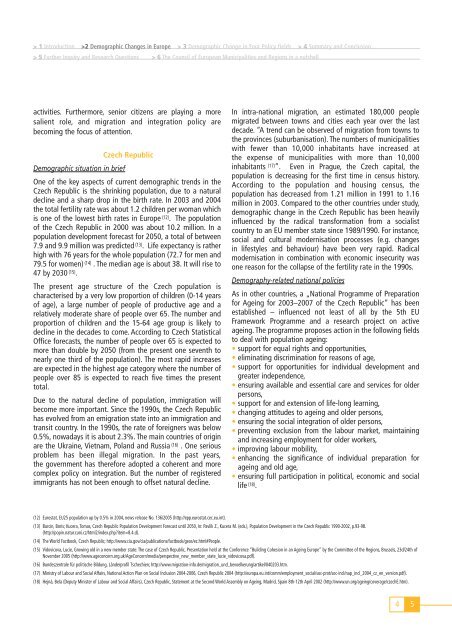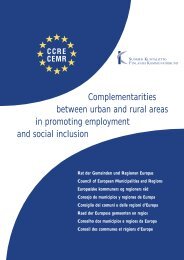The impact of demographic change on local and regional government
The impact of demographic change on local and regional government
The impact of demographic change on local and regional government
Create successful ePaper yourself
Turn your PDF publications into a flip-book with our unique Google optimized e-Paper software.
1 Introducti<strong>on</strong> >2 Demographic Changes in Europe > 3 Demographic Change in Four Policy fields > 4 Summary <strong>and</strong> C<strong>on</strong>clusi<strong>on</strong>> 5 Further Inquiry <strong>and</strong> Research Questi<strong>on</strong>s > 6 <str<strong>on</strong>g>The</str<strong>on</strong>g> Council <str<strong>on</strong>g>of</str<strong>on</strong>g> European Municipalities <strong>and</strong> Regi<strong>on</strong>s in a nutshellactivities. Furthermore, senior citizens are playing a moresalient role, <strong>and</strong> migrati<strong>on</strong> <strong>and</strong> integrati<strong>on</strong> policy arebecoming the focus <str<strong>on</strong>g>of</str<strong>on</strong>g> attenti<strong>on</strong>.Czech RepublicDemographic situati<strong>on</strong> in briefOne <str<strong>on</strong>g>of</str<strong>on</strong>g> the key aspects <str<strong>on</strong>g>of</str<strong>on</strong>g> current <str<strong>on</strong>g>demographic</str<strong>on</strong>g> trends in theCzech Republic is the shrinking populati<strong>on</strong>, due to a naturaldecline <strong>and</strong> a sharp drop in the birth rate. In 2003 <strong>and</strong> 2004the total fertility rate was about 1.2 children per woman whichis <strong>on</strong>e <str<strong>on</strong>g>of</str<strong>on</strong>g> the lowest birth rates in Europe (12) . <str<strong>on</strong>g>The</str<strong>on</strong>g> populati<strong>on</strong><str<strong>on</strong>g>of</str<strong>on</strong>g> the Czech Republic in 2000 was about 10.2 milli<strong>on</strong>. In apopulati<strong>on</strong> development forecast for 2050, a total <str<strong>on</strong>g>of</str<strong>on</strong>g> between7.9 <strong>and</strong> 9.9 milli<strong>on</strong> was predicted (13) . Life expectancy is ratherhigh with 76 years for the whole populati<strong>on</strong> (72.7 for men <strong>and</strong>79.5 for women) (14) .<str<strong>on</strong>g>The</str<strong>on</strong>g> median age is about 38. It will rise to47 by 2030 (15) .<str<strong>on</strong>g>The</str<strong>on</strong>g> present age structure <str<strong>on</strong>g>of</str<strong>on</strong>g> the Czech populati<strong>on</strong> ischaracterised by a very low proporti<strong>on</strong> <str<strong>on</strong>g>of</str<strong>on</strong>g> children (0-14 years<str<strong>on</strong>g>of</str<strong>on</strong>g> age), a large number <str<strong>on</strong>g>of</str<strong>on</strong>g> people <str<strong>on</strong>g>of</str<strong>on</strong>g> productive age <strong>and</strong> arelatively moderate share <str<strong>on</strong>g>of</str<strong>on</strong>g> people over 65. <str<strong>on</strong>g>The</str<strong>on</strong>g> number <strong>and</strong>proporti<strong>on</strong> <str<strong>on</strong>g>of</str<strong>on</strong>g> children <strong>and</strong> the 15-64 age group is likely todecline in the decades to come. According to Czech StatisticalOffice forecasts, the number <str<strong>on</strong>g>of</str<strong>on</strong>g> people over 65 is expected tomore than double by 2050 (from the present <strong>on</strong>e seventh t<strong>on</strong>early <strong>on</strong>e third <str<strong>on</strong>g>of</str<strong>on</strong>g> the populati<strong>on</strong>). <str<strong>on</strong>g>The</str<strong>on</strong>g> most rapid increasesare expected in the highest age category where the number <str<strong>on</strong>g>of</str<strong>on</strong>g>people over 85 is expected to reach five times the presenttotal.Due to the natural decline <str<strong>on</strong>g>of</str<strong>on</strong>g> populati<strong>on</strong>, immigrati<strong>on</strong> willbecome more important. Since the 1990s, the Czech Republichas evolved from an emigrati<strong>on</strong> state into an immigrati<strong>on</strong> <strong>and</strong>transit country. In the 1990s, the rate <str<strong>on</strong>g>of</str<strong>on</strong>g> foreigners was below0.5%, nowadays it is about 2.3%. <str<strong>on</strong>g>The</str<strong>on</strong>g> main countries <str<strong>on</strong>g>of</str<strong>on</strong>g> originare the Ukraine, Vietnam, Pol<strong>and</strong> <strong>and</strong> Russia (16) . One seriousproblem has been illegal migrati<strong>on</strong>. In the past years,the <strong>government</strong> has therefore adopted a coherent <strong>and</strong> morecomplex policy <strong>on</strong> integrati<strong>on</strong>. But the number <str<strong>on</strong>g>of</str<strong>on</strong>g> registeredimmigrants has not been enough to <str<strong>on</strong>g>of</str<strong>on</strong>g>fset natural decline.In intra-nati<strong>on</strong>al migrati<strong>on</strong>, an estimated 180,000 peoplemigrated between towns <strong>and</strong> cities each year over the lastdecade. “A trend can be observed <str<strong>on</strong>g>of</str<strong>on</strong>g> migrati<strong>on</strong> from towns tothe provinces (suburbanisati<strong>on</strong>). <str<strong>on</strong>g>The</str<strong>on</strong>g> numbers <str<strong>on</strong>g>of</str<strong>on</strong>g> municipalitieswith fewer than 10,000 inhabitants have increased atthe expense <str<strong>on</strong>g>of</str<strong>on</strong>g> municipalities with more than 10,000inhabitants (17) ”. Even in Prague, the Czech capital, thepopulati<strong>on</strong> is decreasing for the first time in census history.According to the populati<strong>on</strong> <strong>and</strong> housing census, thepopulati<strong>on</strong> has decreased from 1.21 milli<strong>on</strong> in 1991 to 1.16milli<strong>on</strong> in 2003. Compared to the other countries under study,<str<strong>on</strong>g>demographic</str<strong>on</strong>g> <str<strong>on</strong>g>change</str<strong>on</strong>g> in the Czech Republic has been heavilyinfluenced by the radical transformati<strong>on</strong> from a socialistcountry to an EU member state since 1989/1990. For instance,social <strong>and</strong> cultural modernisati<strong>on</strong> processes (e.g. <str<strong>on</strong>g>change</str<strong>on</strong>g>sin lifestyles <strong>and</strong> behaviour) have been very rapid. Radicalmodernisati<strong>on</strong> in combinati<strong>on</strong> with ec<strong>on</strong>omic insecurity was<strong>on</strong>e reas<strong>on</strong> for the collapse <str<strong>on</strong>g>of</str<strong>on</strong>g> the fertility rate in the 1990s.Demography-related nati<strong>on</strong>al policiesAs in other countries, a „Nati<strong>on</strong>al Programme <str<strong>on</strong>g>of</str<strong>on</strong>g> Preparati<strong>on</strong>for Ageing for 2003–2007 <str<strong>on</strong>g>of</str<strong>on</strong>g> the Czech Republic“ has beenestablished – influenced not least <str<strong>on</strong>g>of</str<strong>on</strong>g> all by the 5th EUFramework Programme <strong>and</strong> a research project <strong>on</strong> activeageing. <str<strong>on</strong>g>The</str<strong>on</strong>g> programme proposes acti<strong>on</strong> in the following fieldsto deal with populati<strong>on</strong> ageing:• support for equal rights <strong>and</strong> opportunities,• eliminating discriminati<strong>on</strong> for reas<strong>on</strong>s <str<strong>on</strong>g>of</str<strong>on</strong>g> age,• support for opportunities for individual development <strong>and</strong>greater independence,• ensuring available <strong>and</strong> essential care <strong>and</strong> services for olderpers<strong>on</strong>s,• support for <strong>and</strong> extensi<strong>on</strong> <str<strong>on</strong>g>of</str<strong>on</strong>g> life-l<strong>on</strong>g learning,• changing attitudes to ageing <strong>and</strong> older pers<strong>on</strong>s,• ensuring the social integrati<strong>on</strong> <str<strong>on</strong>g>of</str<strong>on</strong>g> older pers<strong>on</strong>s,• preventing exclusi<strong>on</strong> from the labour market, maintaining<strong>and</strong> increasing employment for older workers,• improving labour mobility,• enhancing the significance <str<strong>on</strong>g>of</str<strong>on</strong>g> individual preparati<strong>on</strong> forageing <strong>and</strong> old age,• ensuring full participati<strong>on</strong> in political, ec<strong>on</strong>omic <strong>and</strong> sociallife (18) .(12) Eurostat, EU25 populati<strong>on</strong> up by 0.5% in 2004, news release No. 136/2005 (http://epp.eurostat.cec.eu.int).(13) Burcin, Boris; Kucera, Tomas, Czech Republic Populati<strong>on</strong> Development Forecast until 2050, In: Pavlik Z., Kucera M. (eds.), Populati<strong>on</strong> Development in the Czech Republic 1990-2002, p.93-98.(http://popin.natur.cuni.cz/html2/index.php?item=8.4.d).(14) <str<strong>on</strong>g>The</str<strong>on</strong>g> World Factbook, Czech Republic; http://www.cia.gov/cia/publicati<strong>on</strong>s/factbook/geos/ez.html#People.(15) Vidovicova, Lucie, Growing old in a new member state: <str<strong>on</strong>g>The</str<strong>on</strong>g> case <str<strong>on</strong>g>of</str<strong>on</strong>g> Czech Republic, Presentati<strong>on</strong> held at the C<strong>on</strong>ference “Building Cohesi<strong>on</strong> in an Ageing Europe“ by the Committee <str<strong>on</strong>g>of</str<strong>on</strong>g> the Regi<strong>on</strong>s, Brussels, 23d/24th <str<strong>on</strong>g>of</str<strong>on</strong>g>November 2005 (http://www.agec<strong>on</strong>cern.org.uk/AgeC<strong>on</strong>cern/media/perspective_new_member_state_lucie_vidovicova.pdf).(16) Bundeszentrale für politische Bildung, Länderpr<str<strong>on</strong>g>of</str<strong>on</strong>g>il Tschechien; http://www.migrati<strong>on</strong>-info.de/migrati<strong>on</strong>_und_bevoelkerung/artikel/040203.htm.(17) Ministry <str<strong>on</strong>g>of</str<strong>on</strong>g> Labour <strong>and</strong> Social Affairs, Nati<strong>on</strong>al Acti<strong>on</strong> Plan <strong>on</strong> Social Inclusi<strong>on</strong> 2004-2006, Czech Republic 2004 (http://europa.eu.int/comm/employment_social/soc-prot/soc-incl/nap_incl_2004_cz_en_versi<strong>on</strong>.pdf).(18) Hejná, Bela (Deputy Minister <str<strong>on</strong>g>of</str<strong>on</strong>g> Labour <strong>and</strong> Social Affairs), Czech Republic, Statement at the Sec<strong>on</strong>d World Assembly <strong>on</strong> Ageing, Madrid, Spain 8th-12th April 2002 (http://www.un.org/ageing/coverage/czechE.htm).45














![[ ] Les jumelages pour le monde de demain](https://img.yumpu.com/29721946/1/190x96/-les-jumelages-pour-le-monde-de-demain.jpg?quality=85)

